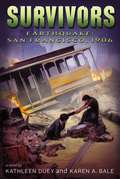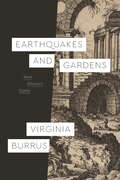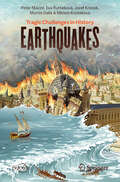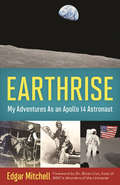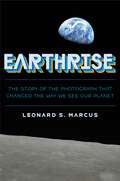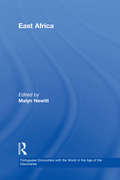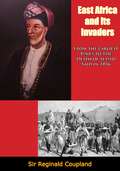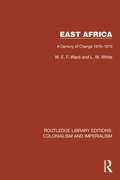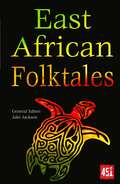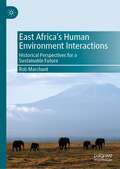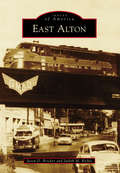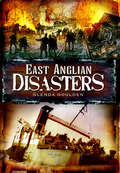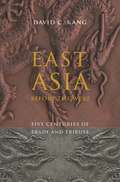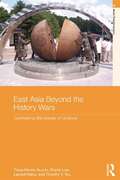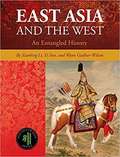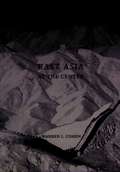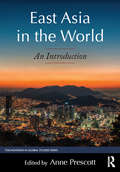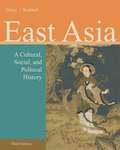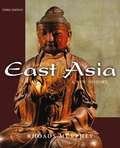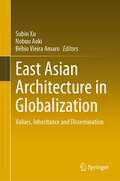- Table View
- List View
Earthquake: San Francisco, 1906
by Kathleen Duey Karen A. BaleCan two kids survive the biggest disaster of 1906? Find out in this gripping tale of historical fiction, part of the Survivors series.Brendan O'Connor is delivering pastries to the bustling businesses and elegant hotels of San Francisco, dreaming that someday he will be part of that life. Li Dai Yue is running from the isolated security of Chinatown, distraught over the marriage her uncle has arranged for her. Chance throws them together on the day of the San Francisco earthquake. Can two strangers from such different worlds work together to survive the terror of crumbling buildings, fire, looting, and chaos?
Earthquakes and Gardens: Saint Hilarion’s Cyprus (Class 200: New Studies in Religion)
by Virginia BurrusEssays about ruination, resilience, reading, and religion generated by a reflection on a fourth-century hagiography. In Jerome’s Life of Saint Hilarion, a fourth-century saint briefly encounters the ruins of an earthquake-toppled city and a haunted garden in Cyprus. From these two fragmentary passages, Virginia Burrus delivers a series of sweeping meditations on our experience of place and the more-than-human worlds—the earth and its gods—that surround us. Moving between the personal and geological, Earthquakes and Gardens ruminates on destruction and resilience, ruination and resurgence, grief and consolation in times of disaster and loss. Ultimately, Burrus’s close readings reimagine religion as a practice that unsettles certainty and develops mutual flourishing.
Earthquakes and Gardens: Saint Hilarion’s Cyprus (Class 200: New Studies in Religion)
by Virginia BurrusEssays about ruination, resilience, reading, and religion generated by a reflection on a fourth-century hagiography. In Jerome’s Life of Saint Hilarion, a fourth-century saint briefly encounters the ruins of an earthquake-toppled city and a haunted garden in Cyprus. From these two fragmentary passages, Virginia Burrus delivers a series of sweeping meditations on our experience of place and the more-than-human worlds—the earth and its gods—that surround us. Moving between the personal and geological, Earthquakes and Gardens ruminates on destruction and resilience, ruination and resurgence, grief and consolation in times of disaster and loss. Ultimately, Burrus’s close readings reimagine religion as a practice that unsettles certainty and develops mutual flourishing.
Earthquakes and Gardens: Saint Hilarion’s Cyprus (Class 200: New Studies in Religion)
by Virginia BurrusEssays about ruination, resilience, reading, and religion generated by a reflection on a fourth-century hagiography. In Jerome’s Life of Saint Hilarion, a fourth-century saint briefly encounters the ruins of an earthquake-toppled city and a haunted garden in Cyprus. From these two fragmentary passages, Virginia Burrus delivers a series of sweeping meditations on our experience of place and the more-than-human worlds—the earth and its gods—that surround us. Moving between the personal and geological, Earthquakes and Gardens ruminates on destruction and resilience, ruination and resurgence, grief and consolation in times of disaster and loss. Ultimately, Burrus’s close readings reimagine religion as a practice that unsettles certainty and develops mutual flourishing.
Earthquakes: Tragic Challenges in History (Springer Praxis Books)
by Peter Moczo Jozef Kristek Martin Galis Miriam Kristekova Eva RutšekováDiscover the profound, surprising, and instructive tales embedded within the tragic earthquakes and tsunamis of the years 1755, 1906, 1960, 1985, 2004, 2011, and 2023. Uncover the impact these events have had on our understanding of the planet we call home and explore how they shaped the destinies of entire nations.In this book, you’ll delve into the intriguing connection between seismic events and human missions to the Moon and Mars; pondering the warnings they carry for our future. As seismic risks on Earth escalate and humanity extends its reach into space, these challenges become pivotal for both current and future seismologists.Lastly, this book will allow you to embark on a riveting journey through the seismic tapestry of our past, present, and the uncharted territories of our future.
Earthrise: My Adventures as an Apollo 14 Astronaut
by Ellen Mahoney Dr Brian Cox Edgar MitchellThe inspiring and fascinating biography of the sixth man to ever walk on the Moon Of the nearly seven billion people who live on Earth, only 12 have walked on the Moon and Dr. Edgar Mitchell was one of them. Earthrise is a vibrant memoir for young adults featuring the life story of this internationally known Apollo 14 astronaut. The book focuses on Edgar's amazing journey to the Moon in 1971 and highlights the many steps he took to get there, including growing up as a farm boy on a ranch; living in Roswell, New Mexico, during the alleged UFO crash; graduating from Carnegie Mellon and MIT; being a navy combat pilot; and becoming a NASA astronaut. In engaging and suspenseful prose he details his historic flight to the Moon, describing everything from the very practical--eating, sleeping, and going to the bathroom in space--to the metaphysical, such as the life-changing sensation of connectedness to the universe that he felt and that has been described, in varying degrees, by many astronauts. Extensive resources include annotated lists of websites about space, museums and organizations, films and videos, and books for further reading.
Earthrise: The Story of the Photograph That Changed the Way We See Our Planet
by Leonard S. MarcusFrom award-winning historian Leonard S. Marcus, Earthrise is a unique middle-grade nonfiction book about the astonishing photograph taken during the Apollo 8 mission that forever shifted the way we view ourselves and our planet.Gazing out the window of the Apollo 8 spacecraft on Christmas Eve, 1968, NASA astronaut Bill Anders grabbed his camera and snapped the iconic color photo of our planet rising over the lunar horizon. Not long after the crew’s safe return, NASA developed Anders’s film and released “Earthrise” to the world. It soon became one of the most viewed and consequential photographs in all of human history, inspiring the first Earth Day in 1970 and boosting the global environmental movement. In the decades since, this incredible photograph of our small yet beautiful, familiar yet strange, “blue marble” has moved billions to rethink their understanding of our home planet, and even their very idea of “home.” A companion to Marcus’s acclaimed Mr. Lincoln Sits for His Portrait—a unique biography of America’s sixteenth president centered around one famous 1864 photo—Earthrise uses the same technique of exploring a key moment in US history through the lens of an iconic photograph. This rocket-paced, compact, and highly accessible nonfiction book includes a trove of black-and-white images and related materials throughout. This is perfect for elementary and middle school kids ages 10-14, or in grades 5 through 8, who love:● Outer space, astronauts, and STEM-related books● Fascinating dives into American history ● Quick and engaging nonfiction reads
East Africa (Portuguese Encounters with the World in the Age of the Discoveries)
by Malyn NewittThe Portuguese appear to have been the first European visitors to encounter East Africa, with the arrival of a lone traveller, Pero da Covilham, in c.1491. Covilham left no account of his experiences, so Vasco da Gama had little idea of what to expect when he led his first voyage to the region in 1497. The account of this expedition paints a vivid portrait of the first contacts between Portugal and the coastal peoples of East Africa. This account, together with a wealth of carefully selected documents comprise this volume of writings which detail Portugal’s relationship with East Africa from the late fifteenth century through to the seventeenth century. As these documents demonstrate, the best Portuguese writers had a deep interest in the African peoples and carefully observed the way their societies worked. The Portuguese in East Africa lived alongside their African subjects and the independent chiefs and to a large extent adopted their life style, technology, business practices, and even their beliefs and customs. This collection of contemporary writings from the period brings to life this extraordinary relationship.
East Africa and Its Invaders: From the Earliest Times to the Death of Seyyid Said in 1856
by Sir Reginald CouplandEast Africa and Its Invaders, originally published in 1938, covers the history of mid-East Africa—the area between Mozambique and Cape Guardafui—from its beginnings down to the death of the greatest Arab ruler in East Africa, Seyyid Said, in 1856.The author—prominent British Empire historian Sir Reginald Coupland (1884-1952) and a longtime Oxford professor, best known for his scholarship on African history—describes in detail, and mainly from hitherto unpublished sources, the character of Arab rule in East Africa and the impact on its people of European and American ‘invaders’: merchants, missionaries, explorers, and political agents. Special attention is given to the British efforts to suppress the Arab Slave Trade.
East Africa: A Century of Change 1870–1970 (Routledge Library Editions: Colonialism and Imperialism #24)
by W.E.F. Ward L.W. WhiteEast Africa (1971) examines the century from 1870 that saw the emergence of East Africa from an ancient isolation into the modern world. This survey pays attention to the social and economic as well as the political history of this transition, and takes pains to understand the ideas and motives of the various groups who make up the population of East Africa. It closely examines the African peoples’ struggle for economic as well as political independence from their colonisers.
East African Folktales (The World's Greatest Myths and Legends)
by Flame Tree StudioFrom the rift valley come stories of gods, tricksters, cattle and ogres from the many peoples of East Africa.Traditional stories bring a deeper understanding of the movement of peoples across East Africa. Common roots and differences between ancient peoples create a lively portrait with their fragile, powerful gods. The modern nations of Kenya, Tanzania, Uganda, Burundi and Rwanda inherit the folk and mythic tales of the rift valley region. Here you'll find stories of ogres and tricksters, riddles and poems, figures such as the first man (Gikuyu) and woman (Mumbi), and great heroes of history such as Liongo. This new collection is created for the modern reader. FLAME TREE 451: From myth to mystery, the supernatural to horror, fantasy and science fiction, Flame Tree 451 offers a healthy diet of werewolves and mechanical men, blood-lusty vampires, dastardly villains, mad scientists, secret worlds, lost civilizations and escapist fantasies. Discover a storehouse of tales gathered specifically for the reader of the fantastic.
East Africa’s Human Environment Interactions: Historical Perspectives for a Sustainable Future
by Rob MarchantThis book is an ambitious integration of ecological, archaeological, anthropological land use sciences, drawing on human geography, demography and economics of development across the East Africa region. It focuses on understanding and unpicking the interactions that have taken place between the natural and unnatural history of the East African region and trace this interaction from the evolutionary foundations of our species (c. 200,000 years ago), through the outwards and inwards human migrations, often associated with the adoption of subsistence strategies, new technologies and the arrival of new crops. The book will explore the impact of technological developments such as transitions to tool making, metallurgy, and the arrival of crops also involved an international dimension and waves of human migrations in and out of East Africa. Time will be presented with a widening focus that will frame the contemporary with a particular focus on the Anthropocene (last 500 years) to the present day. Many of the current challenges have their foundations in precolonial and colonial history and as such there will be a focus on how these have evolved and the impact on environmental and human landscapes. Moving into the Anthropocene era, there was increasing exposure to the International drivers of change, such as those associated with Ivory and slave trade. These international trade routes were tied into the ensuing decimation of elephant populations through to the exploitation of natural mineral resources have been sought after through to the present day.The book will provide a balanced perspective on the region, the people, and how the natural and unnatural histories have combined to create a dynamic region. These historical perspectives will be galvanized to outline the future changes and the challenges they will bring around such issues as sustainable development, space for wildlife and people, and the position of East Africa within a globalized world and how this is potentially going to evolve over the coming decades.
East Alton (Images of America)
by Jason D. Bricker Judith M. RichieEast Alton has a long and proud history. From the earliest settlement, Beeman’s (Benen) Fort, in 1811, the village of East Alton has long been an industrial powerhouse. The home of Olin Corporation’s Winchester Division, East Alton’s industrial production played an important part in winning both world wars. East Alton shared a synergistic growth with Olin Corporation. Having all the trappings of a company town, it somehow transcended this to become a thriving diverse community, filled with a dedicated citizenry, strong schools, generous communities of faith, and a guiding government. East Alton’s incorporation in 1893 was just four years before this country’s first economic depression, the Depression of 1897. Overcoming economic challenges and fostering growth has enabled the village not only to survive but also to succeed.
East Anglian Disasters
by Glenda GouldenDisasters are part of our national history and some were so terrible in their consequences, like the Black Death, the Great Fire of London and the Blitz, that they have come to define an era. In regional history, too, they have had an extraordinary effect, and this is the theme of Glenda Gouldens gripping book. From the long history of East Anglia she has selected those disasters that have had the deepest impact and reconstructed them in telling detail. The episodes she recounts were remarkable when they occurred, and they have a grim fascination for us today. She chronicles fires and explosions, the collapse of buildings and bridges, lethal accidents at sea and on the roads and railways, and tragedies resulting from enemy action and acts of God.
East Asia Before the West: Five Centuries of Trade and Tribute (Contemporary Asia in the World)
by David KangFrom the founding of the Ming dynasty in 1368 to the start of the Opium Wars in 1841, China has engaged in only two large-scale conflicts with its principal neighbors, Korea, Vietnam, and Japan. These four territorial and centralized states have otherwise fostered peaceful and long-lasting relationships with one another, and as they have grown more powerful, the atmosphere around them has stabilized.Focusing on the role of the "tribute system" in maintaining stability in East Asia and in fostering diplomatic and commercial exchange, Kang contrasts this history against the example of Europe and the East Asian states' skirmishes with nomadic peoples to the north and west. Although China has been the unquestioned hegemon in the region, with other political units always considered secondary, the tributary order entailed military, cultural, and economic dimensions that afforded its participants immense latitude. Europe's "Westphalian" system, on the other hand, was based on formal equality among states and balance-of-power politics, resulting in incessant interstate conflict. Scholars tend to view Europe's experience as universal, but Kang upends this tradition, emphasizing East Asia's formal hierarchy as an international system with its own history and character. This approach not only recasts our understanding of East Asian relations but also defines a model that applies to other hegemonies outside the European order.
East Asia Beyond the History Wars: Confronting the Ghosts of Violence (Asia's Transformations)
by Tessa Morris-Suzuki Timothy Y. Tsu Morris Low Leonid PetrovEast Asia is now the world’s economic powerhouse, but ghosts of history continue to trouble relations between the key countries of the region, particularly between Japan, China and the two Koreas. Unhappy legacies of Japan’s military expansion in pre-war Asia prompt on-going calls for apologies, while conflicts over ownership of cultural heritage cause friction between China and Korea, and no peace treaty has ever been signed to conclude the Korean War. For over a decade, the region’s governments and non-government groups have sought to confront the ghosts of the past by developing paths to reconciliation. Focusing particularly on popular culture and grassroots action, East Asia beyond the History Wars explores these East Asian approaches to historical reconciliation. This book examines how Korean historians from North and South exchange ideas about national history, how Chinese film-makers reframe their views of the war with Japan, and how Japanese social activists develop grassroots reconciliation projects with counterparts from Korea and elsewhere. As the volume’s studies of museums, monuments and memorials show, East Asian public images of modern history are changing, but change is fragile and uncertain. This unfinished story of East Asia’s search for historical reconciliation has important implications for the study of popular memory worldwide. Presenting a fresh perspective on reconciliation which draws on both history and cultural studies, this book will be welcomed by students and scholars working in the fields of Asian history, Asian culture and society as well as those interested in war and memory studies more generally.
East Asia and the West
by Yi Sun Xiao Bing Li Wynn Gadkar-WilcoxEast Asia and the West: An Entangled History provides readers with a comprehensive overview of modern East Asian civilizations. The text demonstrates how China, Korea, Japan, and Vietnam developed into modern nations through interactions with Western ideas and military power. <p><p> Part One of the text provides an overview and historical background of premodern East Asia, highlighting differences and similarities between China, Korea, Japan, and Vietnam, and significant partnerships and innovations from the 1500s to the 1800s. In Part Two, students learn why certain areas adopted an isolationist policy against Western influence, while others welcomed the influence. Part Three focuses on confrontation and Westernization, featuring discussion of the Opium Wars, the Meiji Transformation, and French colonization in Indochina. Part Four covers major events that occurred during World War II, including the communist movements in East Asia during the war. The final part examines the competition and confrontation between the capitalist and communist systems during the Cold War in East Asia. <p><p> The text features transliteration notes, maps, and an expansive bibliography to provide students with a complete and immersive learning experience.
East Asia at the Center: Four Thousand Years of Engagement with the World
by Warren I. CohenA common misconception holds that Marco Polo "opened up" a closed and recalcitrant "Orient" to the West. However, this sweeping history covering 4,000 years of international relations from the perspective of China, Japan, Korea, and Southeast Asia shows that the region's extensive involvement in world affairs began thousands of years ago. In a time when the writing of history is increasingly specialized, Warren I. Cohen has made a bold move against the grain. In broad but revealing brushstrokes, he paints a huge canvas of East Asia's place in world affairs throughout four millennia. Just as Cohen thinks broadly across time, so too, he defines the boundaries of East Asia liberally, looking beyond China, Japan, and Korea to include Southeast Asia. In addition, Cohen stretches the scope of international relations beyond its usual limitations to consider the vital role of cultural and economic exchanges. Within this vast framework, Cohen explores the system of Chinese domination in the ancient world, the exchanges between East Asia and the Islamic world from the thirteenth to the seventeenth centuries, and the emergence of a European-defined international system in the eighteenth and nineteenth centuries. The book covers the new imperialism of the 1890s, the Manchurian crisis of the early 1930s, the ascendancy of Japan, the trials of World War II, the drama of the Cold War, and the fleeting "Asian Century" from the mid-1970s to the mid-1990s. East Asia at the Center is replete with often-overlooked or little-known facts, such as: • A record of persistent Chinese imperialism in the region • Tibet's status as a major power from the 7th to the 9th centuries C.E., when it frequently invaded China and decimated Chinese armies • Japan's profound dependence on Korea for its early cultural development • The enormous influence of Indian cuisine on that of China • Egyptian and Ottoman military aid to their Muslim brethren in India and Sumatra against European powers • Extensive Chinese sea voyages to Arabia and East Africa -- long before such famous Westerners as Vasco da Gama and Christopher Columbus took to the seas East Asia at the Center's expansive historical view puts the trials and advances of the past four millennia into perspective, showing that East Asia has often been preeminent on the world stage -- and conjecturing that it might be so again in the not-so-distant future.
East Asia at the Center: Four Thousand Years of Engagement with the World
by Warren I. CohenA common misconception holds that Marco Polo "opened up" a closed and recalcitrant "Orient" to the West. However, this sweeping history covering 4,000 years of international relations from the perspective of China, Japan, Korea, and Southeast Asia shows that the region's extensive involvement in world affairs began thousands of years ago. In a time when the writing of history is increasingly specialized, Warren I. Cohen has made a bold move against the grain. In broad but revealing brushstrokes, he paints a huge canvas of East Asia's place in world affairs throughout four millennia. Just as Cohen thinks broadly across time, so too, he defines the boundaries of East Asia liberally, looking beyond China, Japan, and Korea to include Southeast Asia. In addition, Cohen stretches the scope of international relations beyond its usual limitations to consider the vital role of cultural and economic exchanges.Within this vast framework, Cohen explores the system of Chinese domination in the ancient world, the exchanges between East Asia and the Islamic world from the thirteenth to the seventeenth centuries, and the emergence of a European-defined international system in the eighteenth and nineteenth centuries. The book covers the new imperialism of the 1890s, the Manchurian crisis of the early 1930s, the ascendancy of Japan, the trials of World War II, the drama of the Cold War, and the fleeting "Asian Century" from the mid-1970s to the mid-1990s.East Asia at the Center is replete with often-overlooked or little-known facts, such as: A record of persistent Chinese imperialism in the region Tibet's status as a major power from the 7th to the 9th centuries C.E., when it frequently invaded China and decimated Chinese armies Japan's profound dependence on Korea for its early cultural development The enormous influence of Indian cuisine on that of China Egyptian and Ottoman military aid to their Muslim brethren in India and Sumatra against European powers Extensive Chinese sea voyages to Arabia and East Africa—long before such famous Westerners as Vasco da Gama and Christopher Columbus took to the seasEast Asia at the Center's expansive historical view puts the trials and advances of the past four millennia into perspective, showing that East Asia has often been preeminent on the world stage—and conjecturing that it might be so again in the not-so-distant future.
East Asia in the World: An Introduction (Foundations In Global Studies)
by Anne PrescottFrom the Foundations in Global Studies series, this text offers students a fresh, comprehensive, multidisciplinary entry point to East Asia. After a brief introduction to the study of East Asia, the early chapters of the book survey the essentials of East Asian history; important historical narratives; and the region's languages, religions, and global connections. Students are guided through the material with relevant maps, resource boxes, and text boxes that support and guide further independent exploration of the topics at hand. The second half of the book features interdisciplinary case studies, each of which focuses on a specific country or region and a particular issue. Each chapter gives a flavor for the cultural distinctiveness of the particular country yet also draws attention to global linkages. Readers will come away from this book with an understanding of the larger historical, political, and cultural frameworks that shaped East Asia as we know it today, and of current issues that have relevance in Asia and beyond.
East Asia: A Cultural, Social, and Political History
by Anne Walthall Patricia EbreyWritten by top scholars in the field, EAST ASIA: A CULTURAL, SOCIAL, AND POLITICAL HISTORY, 3E delivers a comprehensive cultural, political, economic, and intellectual history of East Asia, while focusing on the narratives and histories of China, Japan, and Korea in a larger, global context. A range of primary source documents spotlights women's independence, students-turned-soldiers, and other stirring issues, while intriguing biographical sketches throughout highlight the lives of popular figures and ordinary people alike.
East Asia: A Cultural, Social, and Political History, Volume II: From 1600
by Patricia Buckley Ebrey Anne WalthallWritten by top scholars in the field, EAST ASIA: A CULTURAL, SOCIAL, AND POLITICAL HISTORY, VOLUME II: FROM 1600, 3E delivers a comprehensive cultural, political, economic, and intellectual history of East Asia, while focusing on the narratives and histories of China, Japan, and Korea in a larger, global context. Full color inserts on such topics as food, clothing, and art objects illustrate the rich artistic heritage of East Asia. A range of primary source documents spotlights women's independence, students-turned-soldiers, and other stirring issues, while intriguing biographical sketches throughout highlight the lives of popular figures and ordinary people alike.
East Asia: A New History
by Rhoads MurpheyAn introduction to the history of East Asia from the earliest times to the present, suitable for use as a text in courses on East Asia. This edition includes more information on Daoism, pre-modern and modern Vietnam and Korea, contemporary China and Japan, and the role of women generally.
East Asian Architecture in Globalization: Values, Inheritance and Dissemination
by Subin Xu Nobuo Aoki Bébio Vieira AmaroThis book collects a selected list of peer-reviewed papers presented at EAAC 2017, International Conference on East Asian Architectural Culture, the leading conference on architectural history and built heritage conservation in the East Asia region. While centered around the core issue of globalization and its complex effects on East Asian architectural cultures, the selected papers were arranged into four major sub-topics: Historical & Theoretical Research; Conservation Methodology & Technology; Adaptive Reuse; and Community Design. All together, this collection showcases the most recent disciplinary developments in East Asian countries, as well as the main concerns and prospects of leading practitioners. The wide range of contributions and perspectives included here in English language for a global audience should be of considerable appeal to all scholars and professionals in the fields of architectural and urban design, history of the built environment, and heritage conservation policies and methods.
East Asian Art History in a Transnational Context (Routledge Research in Art History)
by Eriko Tomizawa-Kay Toshio WatanabeThis is the first comprehensive English-language study of East Asian art history in a transnational context, and challenges the existing geographic, temporal, and generic paradigms that currently frame the art history of East Asia. This pioneering study proposes an important new framework that focuses on the relationship between China, Japan, and Korea. By reconsidering existing concepts of ‘East Asia’, and examining the porousness of boundaries in East Asian art history, the study proposes a new model for understanding trans-local artistic production – in particular the mechanics of interactions – at the turn of the 20th century.
